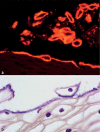Bacterial Vaginosis-Vaginal Polymicrobial Biofilms and Dysbiosis
- PMID: 37097068
- PMCID: PMC10412922
- DOI: 10.3238/arztebl.m2023.0090
Bacterial Vaginosis-Vaginal Polymicrobial Biofilms and Dysbiosis
Abstract
Background: Bacterial vaginosis (BV) is the most common genital disease worldwide in women of sexually active age, with a prevalence of 23-29%. Its traditional definition as dysbiosis, i.e., a disruption of the normal balance of the vaginal microbiota, with a massive increase of facultative and obligate anaerobic bacteria (mainly Gardnerella spp.) and a loss of lactobacilli, accurately describes the change in the vaginal microbiota, but does not explain the underlying pathophysiology.
Methods: This review is based on information in pertinent articles retrieved by a selective literature search and on the authors' own research findings.
Results: Fluorescent in situ hybridization (FISH) has revealed Gardnerella spp.-dominated polymicrobial vaginal biofilm as a cause of ascending gynecologic and pregnancy-related infections, preterm birth, and infertility in patients with BV. The biofilm-induced disturbance of epithelial homeostasis favors co-infection with pathogens of sexually transmitted infection (STI). Standard antibiotic therapy is ineffective against biofilms, and there is thus a recurrence rate above 50%. The characteristic biofilm can be followed as a diagnostic marker and is considered evidence of sexual transmission when heterosexual couples and ejaculate samples are examined. FISH studies have shown that, in addition to biofilm-related vaginosis, there are other dysbiotic changes in the vaginal microbiota that have not yet been characterized in detail. It is therefore justified to speak of a "bacterial vaginosis syndrome."
Conclusion: The simplistic view of BV as dysbiosis, characterizable by microscopic reference methods, has so far led to inadequate therapeutic success. An evaluation of molecular genetic testing methods that would be suitable for routine use and the development of therapeutic agents that are effective against biofilms are urgently needed if the "bacterial vaginosis syndrome" is to be effectively treated.
Figures





Similar articles
-
Growth Forms of Gardnerella spp. and Lactobacillus spp. on Vaginal Cells.Front Cell Infect Microbiol. 2020 Feb 28;10:71. doi: 10.3389/fcimb.2020.00071. eCollection 2020. Front Cell Infect Microbiol. 2020. PMID: 32257961 Free PMC article.
-
Identification and characterization of novel endolysins targeting Gardnerella vaginalis biofilms to treat bacterial vaginosis.NPJ Biofilms Microbiomes. 2022 Apr 19;8(1):29. doi: 10.1038/s41522-022-00285-0. NPJ Biofilms Microbiomes. 2022. PMID: 35440653 Free PMC article.
-
The Vaginal Microbiome: II. Vaginal Dysbiotic Conditions.J Low Genit Tract Dis. 2022 Jan 1;26(1):79-84. doi: 10.1097/LGT.0000000000000644. J Low Genit Tract Dis. 2022. PMID: 34928257 Free PMC article. Review.
-
Vaginal Microbiota.Adv Exp Med Biol. 2016;902:83-93. doi: 10.1007/978-3-319-31248-4_6. Adv Exp Med Biol. 2016. PMID: 27161352 Review.
-
The Female Vaginal Microbiome in Health and Bacterial Vaginosis.Front Cell Infect Microbiol. 2021 Apr 7;11:631972. doi: 10.3389/fcimb.2021.631972. eCollection 2021. Front Cell Infect Microbiol. 2021. PMID: 33898328 Free PMC article. Review.
Cited by
-
Vaginal microbiome and recurrent pregnancy loss.Infect Immun. 2025 Aug 12;93(8):e0005325. doi: 10.1128/iai.00053-25. Epub 2025 Jun 30. Infect Immun. 2025. PMID: 40586555 Free PMC article. Review.
-
Cervicovaginal Microbiome and HPV: A Standardized Approach to 16S/ITS NGS and Microbial Community Profiling for Viral Association.Int J Mol Sci. 2025 Aug 21;26(16):8090. doi: 10.3390/ijms26168090. Int J Mol Sci. 2025. PMID: 40869406 Free PMC article.
-
Vaginal Microbiome: Environmental, Biological, and Racial Influences on Gynecological Health Across the Lifespan.Am J Reprod Immunol. 2024 Dec;92(6):e70026. doi: 10.1111/aji.70026. Am J Reprod Immunol. 2024. PMID: 39670915 Free PMC article. Review.
-
Vaginal microbiota transplantation is a truly opulent and promising edge: fully grasp its potential.Front Cell Infect Microbiol. 2024 Mar 22;14:1280636. doi: 10.3389/fcimb.2024.1280636. eCollection 2024. Front Cell Infect Microbiol. 2024. PMID: 38585656 Free PMC article. Review.
-
Lactobacillus plantarum LPYC225 mixture partially modulates the vaginal bacterial community of Gardnerella vaginalis-infected bacterial vaginosis in mice.Food Sci Biotechnol. 2024 Jul 4;33(9):2233-2242. doi: 10.1007/s10068-024-01641-w. eCollection 2024 Jul. Food Sci Biotechnol. 2024. PMID: 39130651 Free PMC article.
References
-
- Peebles K, Velloza J, Balkus JE, McClelland RS, Barnabas RV. High global burden and costs of bacterial vaginosis: a systematic review and meta-analysis. Sex Transm Dis. 2019;46:304–311. - PubMed
-
- Hoyme UB, Saling E. Effiziente Frühgeburtenvermeidung—Das Thüringer Modell. Gynakol Geburtshilfliche Rundsch. 2004;44:2–9. - PubMed
-
- Van Oostrum N, De Sutter P, Meys J, Verstraelen H. Risks associated with bacterial vaginosis in infertility patients: a systematic review and meta-analysis. Hum Reprod. 2013;28:1809–1815. - PubMed
-
- Leitich H, Kiss H. Asymptomatic bacterial vaginosis and intermediate flora as risk factors for adverse pregnancy outcome. Best Pract Res Clin Obstet Gynaecol. 2007;21:375–390. - PubMed
Publication types
MeSH terms
LinkOut - more resources
Full Text Sources
Miscellaneous

